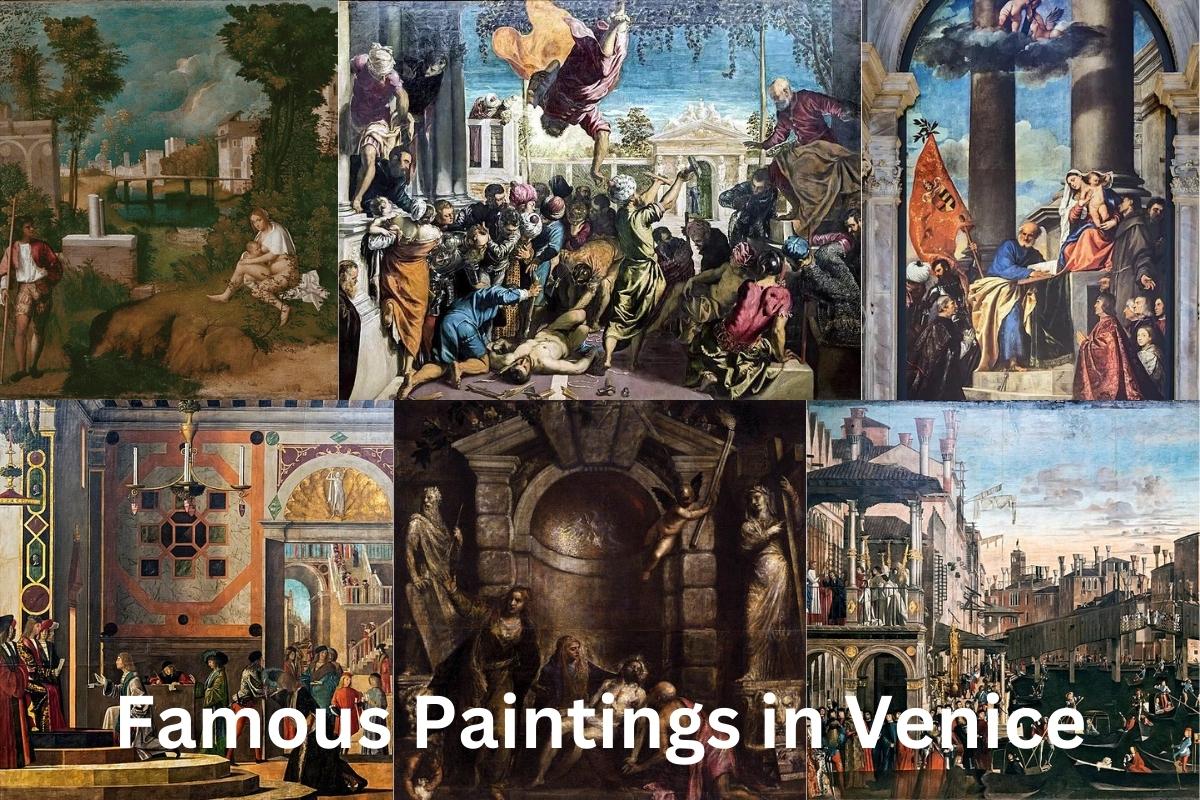A city in the Veneto region of northeastern Italy, Venice is the regional capital. It consists of a network of nearly 400 bridges connecting 118 individual islands connected by canals. The lagoon around the islands is quite shallow.
The ancient Veneti people, who had settled there by the 10th century BC, are the inspiration for the name. For more than a thousand years, from 697 to 1797, Venice served as the republic’s capital.
Also Read: Must See Art in Italy
From the 13th century to the end of the 17th, it was a major financial and nautical power, serving as a staging station for the Crusades and the Battle of Lepanto. It was also a major center of commerce, especially silk, grain, and spice, and of art.
The city was a major hub for a number of significant cultural movements, particularly during the Renaissance with many of the wealthy Venetians becoming patrons of the arts.
Below are some of the most famous paintings in Venice that are currently on display.
Famous Paintings in Venice
1. The Tempest – Giorgione
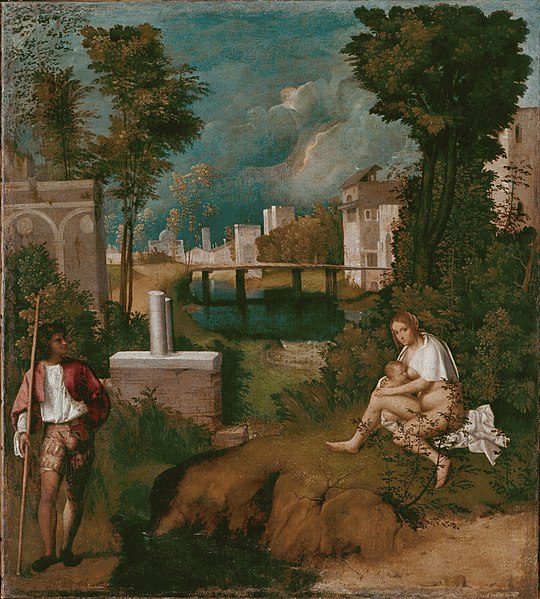
The Tempest, also known as La Tempesta in Italian, is a painting attributed to the Italian Renaissance master Giorgione and dated to between the years 1506 and 1508.
The artwork was originally commissioned by Gabriele Vendramin, a nobleman from Venice; however, it is now housed in the Gallerie dell’Accademia in Venice, Italy.
Also Read: Best Museums in Venice
In spite of the fact that art historians have had a great deal to say about it, the significance of the scene is still unclear.
The elements of the artwork give the impression that they are preparing for a storm. The lighting is mild, and the colors are muted; the predominant colors are blues and greens.
The landscape is more than just a background; rather, it makes a significant contribution to the genre of early landscape painting. The picture exudes a “quiet” aura, which has and will continue to captivate spectators of the present era.
There is no modern textual explanation for “The Tempest,” and consequently, there is no definitive reading or interpretation of the play.
It could be a scene from classical mythology (perhaps involving Paris and Oenone; or Iasion and Demeter); or it could be a scene from an old Greek pastoral tale. Different people have different interpretations of what it depicts.
2. San Zaccaria Altarpiece – Giovanni Bellini
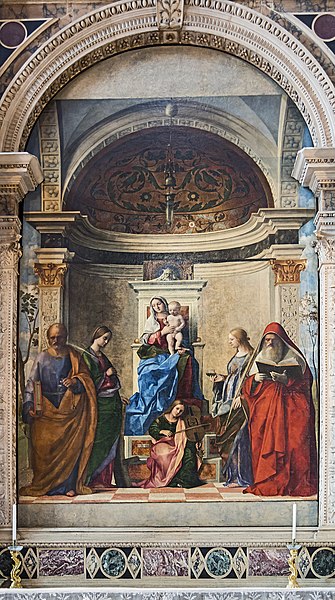
Giovanni Bellini was a Venetian-born artist who is known to have made a number of works related with the city and the significant personalities who lived there during the early years of the Italian Renaissance.
According to historians and experts, Bellini is the most famous artist in his family, but his brother, Gentile, was considerably more famous during their lifetime.
Also Read: Paintings in Italy
The San Zaccaria Altarpiece is one of Bellini’s most famous works. This 1505 painting is often regarded as one of the more significant works of the early Renaissance era, as it was completed only a few decades before other notable figures such as Leonardo da Vinci and Raphael would truly become prominently featured in this movement.
The artwork, also known as Madonna Enthroned with Child and Saints, represents a discourse between the Madonna, or Mary, and Saint Peter, as well as three other notable saints who lived in the years preceding this one.
3. Neptune Offering Gifts to Venice – Giovanni Battista Tiepolo
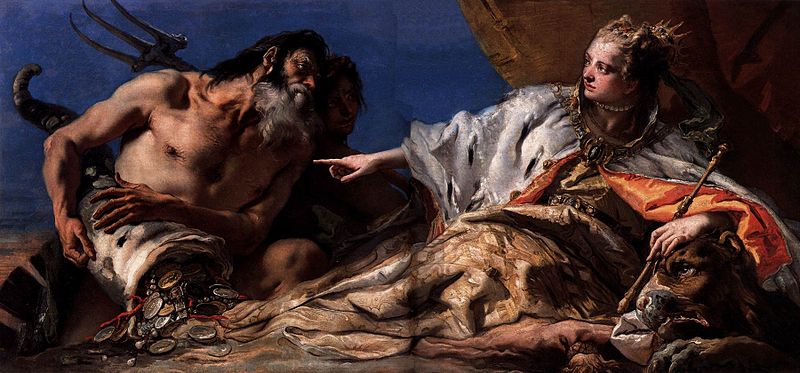
Giovanni Battista Tiepolo (March 5, 1696 – March 27, 1770) was a Rococo-style Italian painter and printmaker from the Republic of Venice.
He is regarded as an important part of the 18th-century Venetian school. He was a prolific artist who worked not only in Italy but also in Germany and Spain.
This painting, which can be found in the Sala delle Quattro Porte of the Doge’s Palace (Palazzo Ducale), is one of the last public works commissioned by the Venetian Republic.
As the city’s thousand-year history came to an end, it commissioned this artwork depicting Neptune pouring forth the wealth of the sea and the riches of commerce before Venice. Tiepolo was commissioned to replace a lost Tintoretto picture.
Because of the painting’s aesthetic peculiarities, the dating is debatable. In respect to the setting, the work employs elements emblematic of Venetian art’s golden age.
4. Pesaro Madonna – Titian
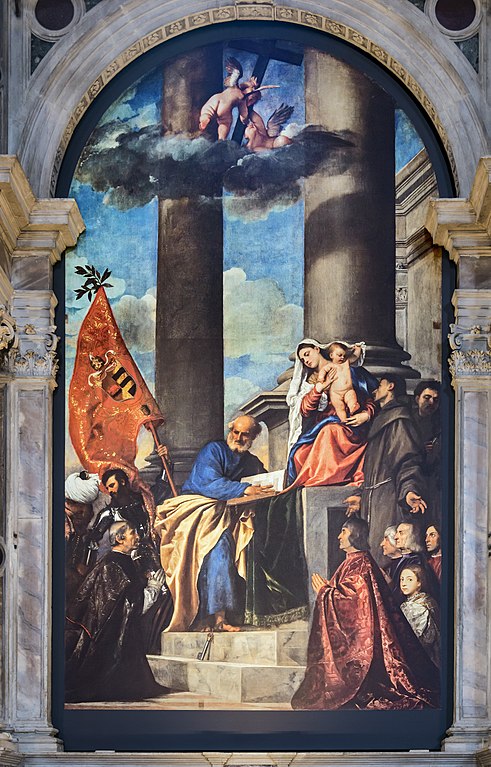
Titian’s Pesaro Madonna (also known as the Madonna di Ca’ Pesaro) is a late Italian Renaissance painting. It was commissioned by Jacopo Pesaro, whose family purchased the chapel in Venice’s Frari Basilica in 1518, where it still stands today.
Jacopo was the Bishop of Paphos in Cyprus, and Alexander VI, the Borgia Pope, had chosen him as commander of the papal fleet. This painting is evocative of one of Titian’s first works, Jacopo Pesaro being given to Saint Peter by Pope Alexander VI, circa 1510-11.
Titian represents his client in a devoted pose, bowing in front of the Virgin and receiving her from Saint Peter. On the stair, Saint Peter’s key is clearly shown; its diagonal plane, pointing toward the Virgin, resembles that of Jacopo.
The Virgin’s position at the top of the stairs alludes to her heavenly function as Madonna della Scala and the Stairway to Heaven. Titian modeled the Virgin Mary in this picture after his wife, who died shortly after giving birth.
5. The Feast in the House of Levi – Paolo Veronese
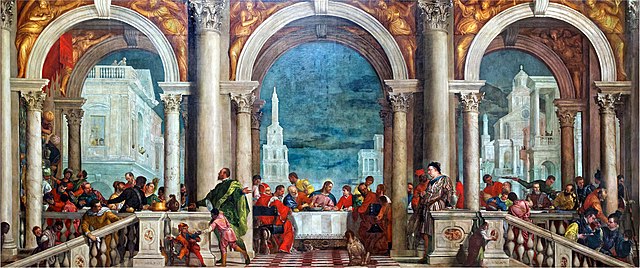
Paolo Veronese is an artist who was born in Venice and spent the majority of his life there during the Italian Renaissance.
Because of his paintings depicting holy people and settings from the Christian New Testament, he is frequently linked to the most important members of the Renaissance movement, such as Da Vinci or Michelangelo.
The Feast in the House of Levi, one of Veronese’s most recognized works, was painted in 1573, during a time when other artists were attempting to earn notoriety by painting scenes from Biblical legends.
This picture depicts a bustling scene of Christ and his followers, but it was considered a highly contentious piece when it was initially shown.
Veronese was brought before a tribunal and charged with heresy for depicting specific figures in the painting. The Feast at Levi’s House – Paolo Veronese
6. Judith II – Gustav Klimt
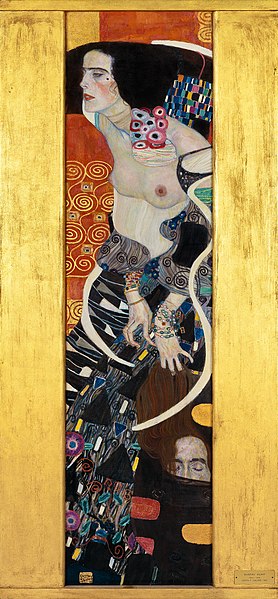
Judith II is the second of Klimt’s works on the theme of Judith and the Head of Holofernes(the first one causing much furore).
The second work is considerably more restrained as it has Jusith gazing off to the side and not straight ahead as in the original.
This artwork was purchased shortly after its debut at the ninth Venice Biennale in 1910 by the gallery of modern art Ca’ Pesaro in Venice.
7. Miracle of the Slave – Tintoretto
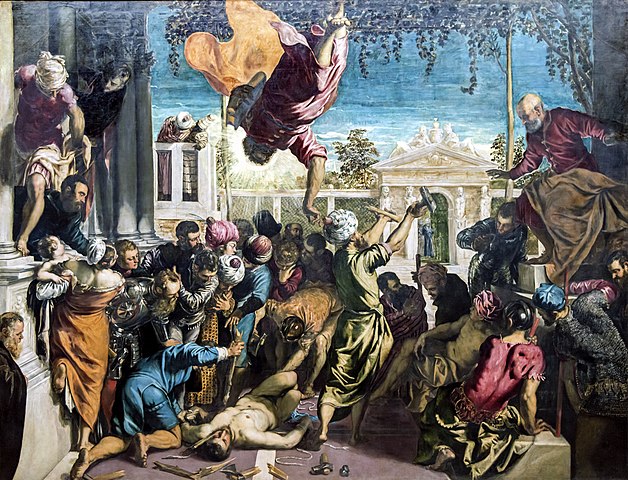
The Miracle of the Slave (1548), also known as The Miracle of St. Mark, was painted by Jacopo Tintoretto, an Italian Renaissance painter, and is currently on exhibit at the Gallerie dell’Accademia in Venice.
It was initially commissioned by the local confraternity Scuola Grande di San Marco.
In this scene from Jacobus de Voragine’s Golden Legend, Saint Mark (the patron saint of Venice) is represented. The saint saves the life of a slave who is about to be martyred because he worships the relics of another saint in the upper half of the scene. Each character is imprinted on a unique architectural setting.
Although Tintoretto definitely drew inspiration from Michelangelo, the rich colors and exquisite detail of the painting are more typical of the Venetian School.
8. Miracle of the Relic of the Cross at the Ponte di Rialto – Vittore Carpaccio
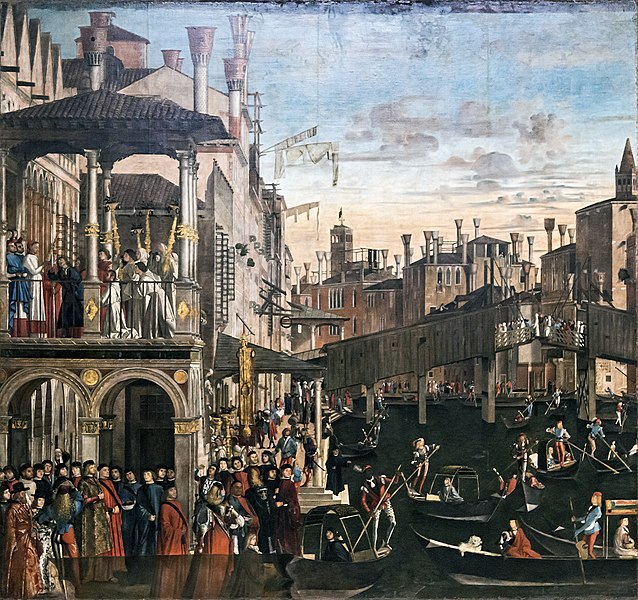
Renaissance artist Vittore Carpaccio painted The Healing of the Madman, also known as The Miracle of the Cross at the Ponte di Rialto, around 1496. It is now on display at Venice’s Gallerie dell’Accademia.
This masterpiece was commissioned for the Scuola Grande di San Giovanni Evangelista’s Grand Hall in Venice, the home of the namesake brotherhood.
Gentile Bellini, Perugino, Vittore Carpaccio, Giovanni Mansueti, Lazzaro Bastiani, and Benedetto Rusconi were among the nine renowned artists whose large-scale canvases were included in the commission.
The paintings were supposed to be about the miraculous effects of a piece of the True Cross. After being given to the fraternity by Philippe de Mézières (or Filippo Maser), chancellor of the Kingdom of Cyprus and Jerusalem in 1369, the item quickly became a revered icon in the city.
All the paintings on canvas were completed between 1494 and 1496. The works by all artists save Perugino were presented to the Gallerie dell’Accademia in 1820 following the collapse of the Venetian Republic and the suppressions by Napoleon.
9. Pietà – Titian
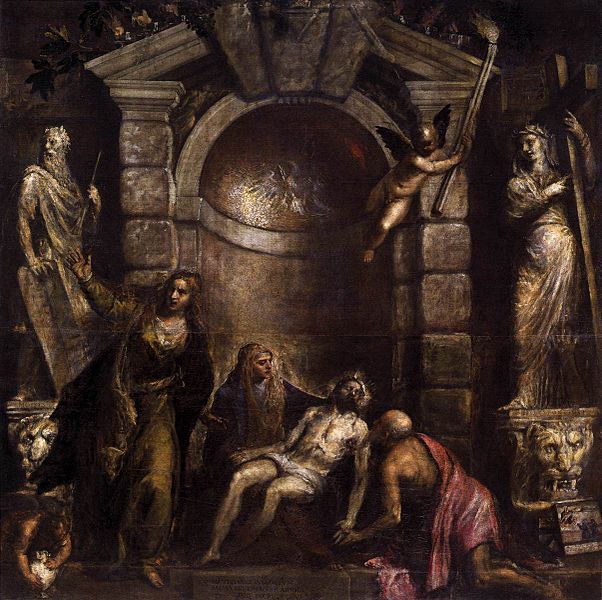
One of Titian’s final works, the Pietà presently in Venice’s Gallerie dell’Accademia, was left unfinished when he passed away in 1576; Palma Giovane was responsible for finishing it.
Two stages of painting were necessary so that it could be displayed in two distinct churches, but Titian’s original intention was for it to hang above his tomb.
The work is one of dozens by Titian that were unfinished when he passed away. Palma Giovane, according to an inscription at the bottom of the painting, completed it, making only minimal changes and trying to emulate Titian’s style.
10. Legend of Saint Ursula – Vittore Carpaccio
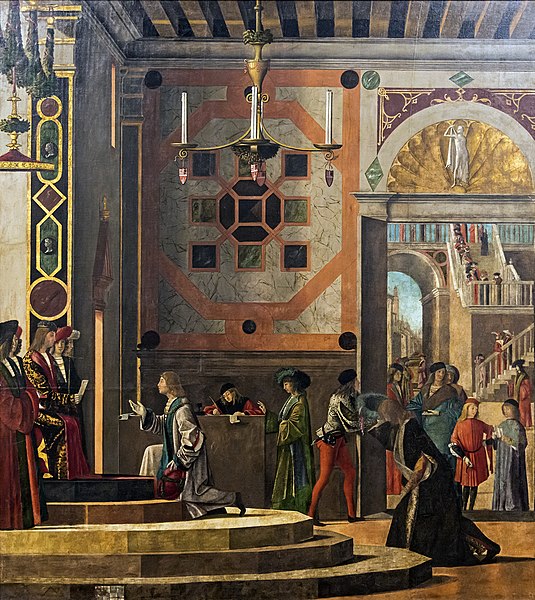
For the Scuola di Sant’Orsola (Ursula) in Venice, which the Loredan family patronized, the Italian Renaissance artist Vittore Carpaccio painted a series of massive wall-paintings on canvas titled The Legend of Saint Ursula (Italian: Storie di sant’Orsola). They have been relocated to the Gallerie dell’Accademia in Venice.
The Loredan family, who patronized the Scuola of St. Ursula and were celebrated for their military exploits against the “infidel” Ottomans, commissioned this cycle of paintings. The confraternity was not one of Venice’s six Scuole Grandi, but it was quite comparable.
Saint Ursula, the daughter of the Christian king of Brittany, was betrothed to a pagan prince in exchange for his conversion to Christianity, and the two of them made a pilgrimage to Rome, according says Jacobus de Voragine’s Golden Legend.
After refusing to become Attila, King of the Huns’ wife, she and her entourage of 10,000 virgins were martyred by him on the journey back to Cologne.

